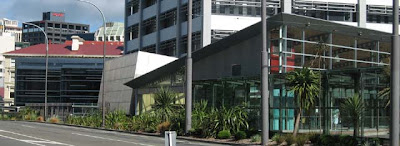In the time since my
summer shakedown post, there's been the expected revival in the Wellington hospitality scene, but it's a little slow and tentative so far. There are, however, several imminent or promised arrivals, so things do seem to be looking up.
The most notable opening is the
General Practitioner, which means that the last of
the Rao empire is back on its feet. That's a good thing in itself, and having a respectfully restored heritage building on a sunny corner returned to the drinking and dining world is something to celebrate. Not everyone will enjoy the sight of the alarmingly-proportioned syringes and other surgical instruments displayed in vitrines, though it's hard to tell whether they're quite as offputting as the clientele, which on the night I visited consisted largely of braying suits, Chardonnay harpies and National party politicians.
I've
already mentioned
Martha's Pantry, which offers coffee and tiny cakes alongside flowers and delicate knick knacks in the decidedly less delicate environs of Karo Drive. There's still little sign of anything else opening up among the polished and empty shells of Upper Cuba St, though there are some faint hints of work going on in the husk of the old
Bodega over in Willis St. Does anyone know what may or may not be happening there?
That's about it for brand new places since February, though two that I was pessimistic about have since reopened.
Mezzaluna had indeed closed, but has since returned as
Dorall. The
Old Bank Bar & Café looked dead, but has instead been split in two, with
Higher Taste occupying the old pokies room while the
Old Bank itself has reopened in the remainder of the space. What was
Cabaret is still active (as an extension of
Chow), but I'll no longer count it as a separate entity.
While two new places have opened, one relatively established business has closed.
Coco lost its "Pacific Vibe" some time ago, and it finally closed its doors yesterday. Whether its demise had anything to do with recent
reports of bad service, or whether that was merely a symptom, is hard to say. It now appears that the space will become some sort of "recycled clothing boutique" or vintage shop.
So, since
my last accounting, we've had a net gain of only one, bringing the change since
the last map in December to a loss of three. But things are about to get interesting, and I can think of at least six brand new places that are about to open in spaces that were previously retail or that didn't exist at all. Some of those are hardly exciting, such as
Esquires Coffee (yet another
chain) at the Holiday Inn and the café set to open in the base of the
Central Stratford apartment hotel in Willis St. The website promises a licensed bistro with a "tapas style" evening menu, but it also promised an April opening, and from the cheap & nasty look of the building itself and its
even nastier companion planned for across the street, I wouldn't expect an unmissable experience.
Others might be more welcome, such as
Mojo and
Caffé Italiano in upper Cuba St (thus making up for the loss of
Coco).
Habebie, which describes itself as an "authentic Lebanese bar and restaurant", should also be worth checking out when it opens in the Oaks complex opposite
Dixon St Deli. Most intriguing is the prospect of a brand-new Cuban café, and not even in Cuba St!
There have also been some blink-and-you'll-miss-them transformations.
Theo's Taverna is now
Kosmos, and
Spice Island has become
Perrett's Corner, though given the history of that site it's hard to say how long it will last.
Orchid Lounge has finally closed, after an unsuccessful half-hearted attempt to revitalise
East West and a brutal (but probably justified) review by David Burton. The new owners are wisely steering well clear of "Asian tapas", and it will become a casual French bistro called
Le Métropolitain. Given that the owners are from Normandy and Lyon, with recent experience at
François and
Pravda, that should really be something to look forward to.








 The
The 





















